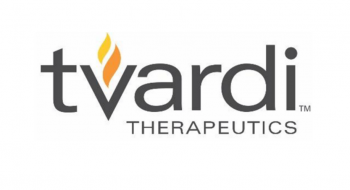Tvardi Therapeutics
Tvardi Therapeutics
Tvardi Therapeutics
Company Overview
(Nasdaq: TVRD)
Innovation: Drug – potential inhibitors of a protein, STAT-3, known to be associated with multiple cancers
Targeted Cancer(s): Hepatocellular Carcinoma, Triple-negative Breast Cancer, Lung Cancer, etc.
Leadership: Imran Alibhai, Ph.D, CEO; Jeno Gyuris, Ph.D; David Tweardy, M.D.; Ron DePinho, M.D. (Click here to view our team)
Stage of Business: Raised $74 Million in Series B Financing; Phase I clinical study of TTI-101 ongoing in adult patients with advanced solid tumors.
Background
Therapeutic Rationale & Product
As STAT3 is an integral regulator of signaling pathways driving diverse diseases, Tvardi mounted an extensive drug screening and medicinal chemistry campaign that has produced a novel chemical series inhibiting STAT3 phosphorylation with robust activity in models of cancer, inflammation or fibrosis. Tvardi holds the exclusive license to a patent estate of highly selective, potent and novel inhibitors targeting STAT3. Its proprietary lead compound, C188-9, formulated for oral administration, is potent and exceptionally selective in vitro and in vivo. Specifically, C188-9 shows robust anti-tumor activity in five models of cancer, five models of chronic inflammatory diseases, and three models of fibrosis. C188-9 has now entered in first in human Phase 1 studies in 4Q17, which will be followed by a rapid and efficient clinical proof-of-concept (PoC) strategy involving multiple Phase II studies in diverse cancers starting 1Q19. Tvardi also is developing an IV formulation of C188-9 for cachexia in patients on chronic dialysis and its C188-9 prodrug that will be orally formulated for treatment of idiopathic pulmonary fibrosis, scleroderma, steroid resistant asthma, and inflammatory bowel disease.
Development Strategy
Tvardi is executing a strategy to achieve rapid PoC in diverse cancers that will enable strategic development of its inhibitors across multiple indications. Accelerated clinical trials will be conducted at MD Anderson Cancer Center, the premier center for clinical trials in cancer, and such trials will be accelerated and de-risked with Tvardi’s CLIA-certified test for STAT3-activation which enables identification of STAT3-activated cancers for enlistment into clinical testing. Following clinical PoC, we will drive towards registration in specific cancer indications as well as conducting combination trials including immunotherapy drugs based on data showing that STAT3 plays a key role in supporting immune suppressive cells that thwart immune checkpoint blockade therapy
Competitive Advantage
A total of 19 patents have been filed covering composition of matter and uses of C188-9. Four patents have issued (US, Canada, Europe, and Australia) that concern composition of matter and uses of C188-9 in cancer. Three additional sets of patents were filed in the US, Canada, Australia, Europe, and Hong Kong that concern composition of matter and use of C188-9 in muscle wasting (cachexia), fibrosis, and allergic reactions. Currently, no viable STAT3 inhibitor agents have been developed. There were three orally bioavailable, small-molecule inhibitors of STAT3 that were under development: Napabucasin (BBI-608; Boston Biomedical) and OPB-31121 and OPB-51602 (Otsuka Pharmaceutical Company). Evidence that BBI-608 targets STAT3 is lacking and it failed to improve responses in a Phase III clinical trial that compared paclitaxel plus BBI-608 vs. paclitaxel alone in gastric and GE junction cancers. In Phase I studies, OPB-31121 and OPB-51602 showed low tolerance, high incidence of side effects, and low efficacy. We have a clear mechanistic understanding of the basis for these molecules, which is not shared by C188-9. Thus, future development of these three competitors of C188-9 is unlikely.
Use of Proceeds
Tvardi’s founding team of experienced entrepreneurs, drug developers, physician scientists seeks to secure $5 million Series A funding to recruit full time management and complete Phase I. This round will be followed by $30 million in Series B funding to achieve clinical PoC and develop its back-up drug series. Significant non-dilutive funding opportunities will also be pursued.


